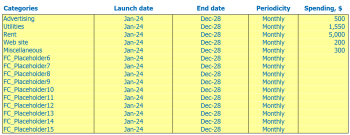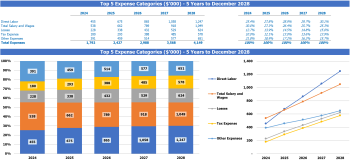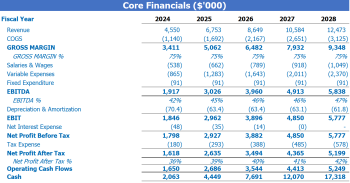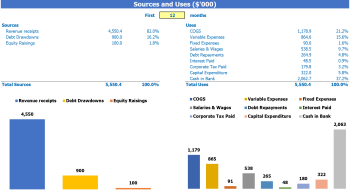- Home
- Sales and revenue
- Running costs
- Financial
Welcome to the world of entrepreneurship, where every dream can come true with the right financial model and business plan . We all have a childhood memory of running a lemonade stand, but have you ever thought about how to turn it into a profitable business? This blog post will walk you through the process of building a financial model for a lemonade stand. We’ll discuss everything from Startup Costs , Profit Margins , Pricing Strategy , Marketing Plan , Financial Projections , Breakeven Analysis , Cash Flow , and Return Return . Let’s dive!
Lemonade Stand Revenue and Sales Forecast
One of the critical components of a lemonade stand financial model is revenue and sales forecasts. These forecasts help determine the expected revenue and sales of the lemonade stand. Launch date, sales ramp-up time, walk-in traffic and growth assumptions, customer and purchase assumptions, and sales seasonality are critical factors in estimating revenue and sales from the lemonade stand.
The launch date is when the lemonade stand opens for business. Sales ramp-up time is the period it will take for the lemonade stand to reach its optimal sales level. Walk-in traffic assumptions are the number of people the booth expects to visit based on the location. Growth assumptions predict the expected increase in sales over time. The customer assumptions estimate the number of repeat customers and the purchase assumptions estimate the average spend per customer.
Sales seasonality is key to understanding when the lemonade stand will experience its peak sales period. With all of these assumptions, a financial projection can be constructed to determine the break-even point, cash flow, return on investment, and profitability. Revenue and sales forecasts are the backbone of a lemonade stand financial model and help define the pricing strategy, marketing plan, and financial projections.
Lemonade Stand Launch Date
Deciding when to launch your lemonade stand can have a significant impact on the success of your business. It is important to consider both internal and external factors when selecting the launch date.
Internal factors , like lemonade stand startup costs and financial projections, should be considered when selecting a launch date. It is essential to ensure that you have the necessary funds to sustain your business through the start-up phase, as well as the following months.
External factors also play a vital role in determining the launch date. Researching your target market and your competition can provide insight into the best time to launch your business. Understanding your customers’ buying habits and seasonal trends can influence the pricing strategy and lemonade marketing plan.
Tips & Tricks:
- Consider launching your lemonade stand at a popular event in your area to increase foot traffic.
- Perform a break-even analysis to determine the minimum level of sales and revenue needed to cover costs.
- Create a cash flow forecast to estimate potential return on investment and future financial projections.
Lemonade Rise Time
When starting a lemonade stand business, it is important to forecast sales to understand how long it will take to reach the sales plateau. Ramp-up time, or the time it takes for a business to achieve a steady stream of sales, must be considered when calculating financial projections, break-even analysis, and ROI.
The sales ramp-up period for your lemonade stand business can vary depending on factors such as location, pricing strategy, and marketing plan. However, in the lemonade stand industry, it usually takes around 3-6 weeks to reach sales plateau.
Tips & Tricks:
- Consider offering special promotions during the ramp-up period to attract more customers.
- Adjust the pricing strategy based on sales during the ramp-up period.
- Invest in targeted marketing efforts to increase awareness and reach your target audience faster.
By forecasting sales and understanding ramp-up time, you can create a solid lemonade business plan that factors in start-up costs, profit margin, and cash flow.
Trafficking in lemonade
During the ramp-up period, the lemonade stand may experience fluctuating walk-in traffic. However, after this period, it is essential to determine the average appointment traffic on weekdays. For example, on Monday there may be fewer customers than on Friday due to the approaching weekend. Therefore, tracking daily averages during the week becomes extremely important.
Entering this data into the financial model can determine which weekdays generate the most revenue and how much lemonade to make to meet demand. Knowing customer traffic allows the owner to prepare lemonade accordingly and minimize waste, which can lead to higher profit margins.
Another crucial input is the average walk-up traffic growth factor. Forecasting the lemonade stand’s financial projections into the future requires assumptions consistent with data from the ramp-up period.
Tips & Tricks:
- Use social media to promote your booth to drive walk-in traffic.
- Sell additional items like cookies or lemon bars to increase sales per customer.
- Offer loyalty cards or discounts to encourage repeat customers.
By using data from the ramp-up period to calculate the walk-up traffic growth factor, the financial model can predict future revenue and profit. The model can calculate the number of customers who will come to the booth on specific weekdays for five years. This valuable data is essential when creating a realistic lemonade stand revenue model and creating a comprehensive lemonade stand business plan.
Hits on the lemonade medium in sales conversion and sales inputs
An important factor in building a financial model for a lemonade stand business is understanding the conversion rate of visitors to new customers, as well as the percentage of repeat customers. Let’s say the booth gets 100 visitors in one day, and 25 of them actually buy lemonade, which means the conversion rate is 25%.
If 10% of those 25 customers become repeat customers, that means there are 2.5 repeat customers per day. If each repeat customer buys an average of 2 cups per month, that equates to 5 cups per month per repeat customer. This information is important to include in the financial model to estimate potential revenue from repeat customers.
Tips & Tricks:
Ways to increase conversion rate and repeat sales
- Improving the aesthetics of the lemonade holder and making it eye-catching will attract more visitors.
- Creating a loyalty program or offering discounts to repeat customers can keep them coming back.
- Providing excellent customer service can keep customers coming back and recommending the booth to others.
Lemonade Stand Sales Mix Appetizers
In our Lemonade Stand store, we have a variety of products that fall under different categories. It is important to distinguish them by entering sales mix assumptions on the product category lever. By doing so, we will be able to better understand our revenue model.
Assuming we have five product categories, say lemonade, flavored water, smoothies, popsicles and cookies, we can now enter the sales mix in percentages for each category for the five forecast years.
For example:
- Lemonade – 40%
- Flavored water – 20%
- Smoothies – 15%
- Popsicles – 10%
- Cookies – 15%
By doing this, we make it easier to track our financial projections, break-even analyzes and cash flow. It also helps us to more accurately determine the pricing strategy, marketing plan and profit margins.
Tips & Tricks:
- Regularly review and adjust your sales mix assumptions as your business grows.
- Use past sales data to inform future sales mix assumptions.
- Experiment with new products to see how they fit into your existing sales mix.
Lemonade Line Means of Sale Means of Appetizers
At our lemonade stand we sell a variety of products. From regular lemonade to pink lemonade and even a special “lemonade of the week” flavor. To make estimating our revenue easier, we have divided our products into categories: Classic, Luxury and Specialty.
When we make assumptions for our financial projections, we enter our average sales amounts at the category level rather than at the individual product level. Let’s see how the average sale amount per product category works:
- Classic : Our classic lemonade is priced at .50 per cup. We estimate that we will sell 50 cups per day in year one, increasing by 10 cups per day each year.
- Deluxe : Our Deluxe Lemonade comes with a special blend of fruit juices and is priced at .50 per cup. We estimate that we will sell 20 cups per day in year one, increasing by 5 cups per day each year.
- Specialty : Our specialty lemonade flavor of the week is priced at .00 per cup. We estimate that we will sell 10 cups per day in year one, increasing by 2 cups per day each year.
Using these assumptions and our sales mix (percentage of each product category sold each day), we can calculate the average ticket size for our lemonade stand.
Tips & Tricks
- Regularly update your assumptions and sales mix as your business grows and changes.
- Consider offering discounts or specials to increase sales and attract customers.
- Monitor your lemonade stand financial projections to make sure you’re on track to meet your goals.
Seasonality of lemonade stand sales
Seasonality is a common factor that affects lemonade stand sales. It is essential to understand the seasonal factors that could lead to a significant reduction in income. For example, there may be higher sales in the summer and lower sales in the winter.
To minimize the impact of seasonality, you need to plan accordingly. For example, a lemonade stand business plan should have a strategy for different seasons. A good pricing strategy can help you maximize profits. You should also consider lemonade stand profit margin, as well as lemonade stand startup costs when creating your business plan.
Performing a Lemonade Stand Break-Even Analysis I would also help you determine the point at which you need to break. Additionally, you must have a strong lemonade stand marketing plan to help you reach more customers.
You can use Lemonade Stand Financial Projections to determine expected revenue, which would help you create a Lemonade Stand Revenue Model and measure your LEMONADE ROI . A good Lemonade Stand Cash Flow analysis would also help you manage your finances effectively.
Tips & Tricks:
- Offer seasonal flavors to attract more customers
- Reduce costs during slow seasons to increase profits
- Consider other beverages and snacks for diversification
Lemonade Stand Operating Expense Forecast
In order to have a successful lemonade stand business, it is important to have a solid financial model in place. A key aspect of this model is the forecasting of operational expenses. These expenses include the cost of goods sold by products, wages and salaries of employees, rent, lease or mortgage payment, utilities and other operating expenses.
| Cost of Goods Sold by Products% | 0 – 0 |
| Salaries and wages of employees | 0 – ,500 |
| Rent, lease or mortgage payment | 0 – ,000 |
| Public services | – 0 |
| Other running costs | 0 – 0 |
| Total | 0 – ,700 |
Having a clear understanding of your operational expenses can help set prices and determine financial projections for your lemonade stand. It’s also important to do a break-even analysis and calculate your return on investment to keep your lemonade stand profitable.
Lemonade Stand Cost of Goods Sold
Cost of Goods Sold (COG) refers to the expenses incurred in producing, manufacturing, and selling a product. In the lemonade stand revenue model, COGs are made up of the cost of lemons, sugar, cups, and labor.
In order to calculate the cogs for your lemonade holder, you need to make a few assumptions. For example:
- The cost of lemons is .75/piece
- Sugar cost is /lb
- The cost of the cups is .10/piece
- Labor cost is /hour
Using the assumptions above, the cogs per cup of lemonade would be: Lemons: 1 lemon/cup x .75/lemon = .75/cup Sugar: 0.2 lb sugar/cup x /lb = .00/cup Cups: 1 cup/cup x .10/cup = .10/cup Labor: 0.1 hour/cup x /hour = .00/cup
Therefore, the total cogs for a cup of lemonade would be .85/cup . To achieve a 50% profit margin, you will need to sell each cup for .70.
Tips & Tricks:
- Consider using cheaper alternatives for some ingredients to reduce COGs
- Include indirect costs such as transportation and maintenance costs in your COGS assumptions
- Perform regular checks to ensure your COGs are in line with your financial projections
Salaries and wages of lemonade employees
In our lemonade stand, we assume that we will have a manager, an assistant manager and two part-time employees. The manager will be in charge of day-to-day operations, inventory management and employee supervision. The Assistant Manager will be responsible for supervising employees, ordering supplies and maintaining the booth. Part-time employees will help make and serve the lemonade, as well as keep the stand clean.
The manager will be hired at the start of the season and will earn ,000 a year. The assistant manager will be hired two weeks before the start of the season and will earn ,000 a year. Each part-time employee will earn per hour, and we assume they will work an average of 5 hours per day, 5 days per week over a 4-month season. This brings the total salary and salary expenses to ,000 for the year.
Tips & Tricks
- Consider hiring high school students for part-time positions, as they often have flexible hours and are willing to work for lower wages.
- Train your employees on the selection by suggesting add-ons like chocolate chips or whipped cream with the lemonade.
Lemonade rent, lease or mortgage payment
When starting your own lemonade stand business, it’s important to understand the costs of your location. Whether you decide to rent, lease, or take a mortgage payment for your booth, each option comes with its own set of assumptions and expenses.
Rent: Renting space for your lemonade stand can be an affordable option, but it also means you won’t have control over the property. You will have to pay monthly rent and you may need to negotiate with the landlord to ensure you get a fair price.
Leasing: Leasing a location for your lemonade stand can give you more control over the property, and a lease can last up to several years. You will have to pay monthly rent, but the rate may be more stable compared to renting.
Mortgage payment: If you own the property for your lemonade stand, a mortgage payment may be the right option for you. A mortgage payment often results in lower monthly payments, but you will have to commit to a long-term financial obligation.
Tips & Tricks:
- Always try to negotiate a fair price to rent or rent
- Consider the long-term commitment of a mortgage payment
- Consider additional costs such as utilities and maintenance when budgeting for a location
lemonade stand utilities
When creating a lemonade business plan , it’s important to consider start-up costs , revenue model , profit margin , and pricing strategy , but don’t forget the utilities too. These are the various services and supplies you will need to keep your business running smoothly.
Some of the typical utilities you’ll need to run a lemonade stand include:
- Electricity to power blender, fridge and other appliances
- Water to make lemonade and clean your equipment
- Ice to keep the lemonade cold
- Pickup pick to keep your stand and surroundings clean
- Paper cuttings, straws, napkins and other supplies that are needed to serve customers
Tips & Tricks:
- Consider getting a portable generator if you operate in a location without access to electricity.
- Try to find a location with access to water, such as a park with a drinking fountain or a public restroom with a sink.
- Buy supplies like cups and straws in bulk to save money in the long run.
By factoring in the cost of utilities when creating your financial projections and breakeven analysis , you can determine the amount of cash flow you’ll need to keep your business afloat and calculate your return on return . Incorporating a marketing plan and establishing a strong online presence can also help attract customers and increase your chances of success.
Lemonade line other running costs
When building a financial model for a lemonade stand, it is important to consider all of the costs associated with running the business. While start-up costs , pricing strategy , and marketing plan are crucial parts of the plan, don’t forget the other running costs .
Other operating costs refer to expenses necessary for the day-to-day operations of your lemonade stand. These costs could include buying ice, cups, straws, napkins and other supplies on a regular basis.
Another example of additional cost is the cost of disposing of second-hand supplies, which may require payment for a sanitation company to regularly come and take away trash and recyclables.
While these running costs may seem small, they can add up over time and impact the profit margin on the lemonade stand . Be sure to report these in your financial model, along with Financial Projections , Breakeven Analysis , Cash Flow , and Return Return . With all of these costs in mind, you can build a financial model that will help ensure the success of your lemonade stand.
Lemonade Stand Financial Forecast
Forecasting your finances is a crucial part of your Lemonade Business Plan . It allows you to determine the Lemonade Stand Startup Costs , Lemonade Stand Revenue Model, Lemonade Stand Pricing Strategy , Lemonade Stand Marketing Plan , Lemonade Stand Financial Projections , and ROI LEMONADE with precision. The forecasts include an Income Statement , Cash Flow Statement , Sources and Uses Report and a Profitability Analysis .
The profitability of the lemonade stand
Once we’ve built a revenue model and understand our start-up costs, we can create a financial projection for our lemonade stand. From there, we can determine our profit and loss (P&L) , which will track our revenue to our net profit. This allows us to visualize the profitability of our business.
A metric for profitability is gross margin , which calculates how much revenue we have left after subtracting the cost of goods sold. Another measure of profitability is the EBITDA margin , which takes into account all expenses related to running the business. These measurements will help us determine if our lemonade stand will be profitable in the long term.
Tips & Tricks:
- Offer special offers or promotions during slow times to increase sales
- Find ways to cut costs, like buying in bulk or sourcing local ingredients
- Monitor your spending closely to make sure you’re not overspending
Overall, by using financial projections and calculating our profits and losses, we can determine the ROI (return on investment) and profit margins for our lemonade stand. This information will help us create a sustainable business plan and marketing strategy to ensure long-term success.
Lemonade stand sources and use of the chart
The sources and uses of funds in the financial model in Excel for Lemonade Stand provides users with an organized summary of where capital is coming from sources and how that capital will be spent in uses. It is important for the total amounts of sources and uses to be equal to each other. Disclosure of sources and uses is particularly critical when the company is considering or going through recapitalization, restructuring, or mergers and acquisitions (M&A).
A helpful tip for creating a solid sources and use statement is to start by calculating start-up costs, such as expenses for purchasing equipment and supplies, renting a location, and marketing the booth. This information can then be used to estimate expected revenues, costs and profit margins using a lemonade stand revenue model, pricing strategy and financial projections. Incorporating break-even analysis, cash flow statements, and ROI calculations can also help refine the financial plan and ensure the lemonade stand is financially viable and sustainable.
Tips & Tricks:
- Don’t forget to take contingencies into account, such as unexpected repairs or fluctuating demand.
- Consider different financing options, such as crowdfunding or small business loans, to help cover start-up costs.
- Be realistic about revenue projections and avoid overestimating potential sales.
- Be strategic about pricing, taking into account competition, target audience and production costs.
Building a financial model for your lemonade stand is crucial to your business success. With the right Lemonade Stand Revenue Model , Lemonade Business Plan , Lemonade Stand Startup Costs , and Lemonade Stand Pricing Strategy , you can measure your Lemonade Stand Profit Margin and estimate your Lemonade Stand Financial Projections . By performing a Lemonade Stand Break-Even Analysis and tracking your Lemonade Stand Cash Flow , you can calculate your LEMONADE ROI . Overall, taking the time to build a comprehensive financial model for your lemonade stand can ensure your business is profitable and sustainable.














